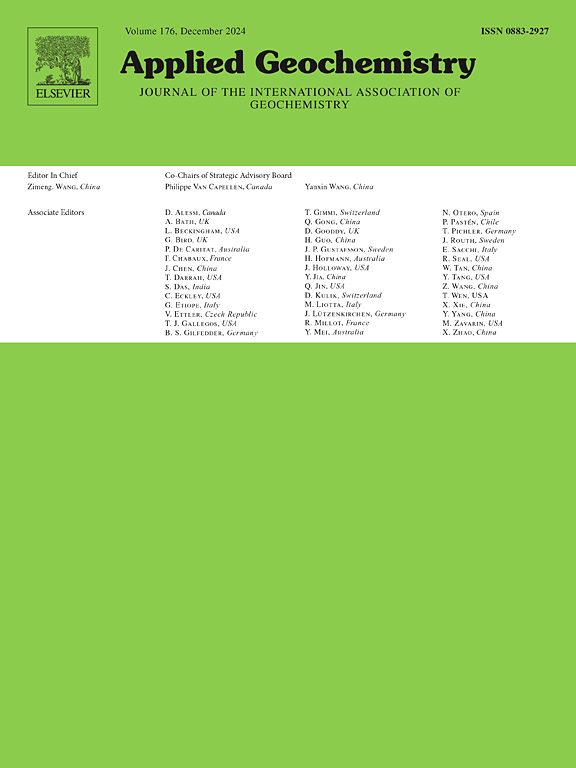流体地球化学对碳酸盐岩地热系统地质成因的制约:中国西藏南部曲珠穆案例研究
IF 3.1
3区 地球科学
Q1 GEOCHEMISTRY & GEOPHYSICS
引用次数: 0
摘要
中国藏南地区高温地热系统分布广泛,具有巨大的开发利用潜力。然而,目前该地区的研究主要集中在长岩储层地热系统,而对碳酸盐岩储层地热系统的研究还很少。因此,此类地热资源的大规模开发利用仍然受到限制。本研究选择了西藏南部曲珠穆典型的碳酸盐岩地热系统作为研究对象。基于地热水的水化学和同位素(δD、δ18O、δ13C、δ34S 和 δ11B)特征,研究了曲珠穆地热水的地球化学成因,评估了地热系统的储层温度,确定了其热源,并最终提出了地热系统的成因机制。地热水的化学成分表明,其主要来源于海洋碳酸盐岩和电气石花岗岩的溶解。此外,改进的矿物组合地温仪显示,储层温度变化范围为 118-150 ℃(平均为 128 ℃)。同处桑日-库纳断裂带的典型岩浆地热系统--古堆系统与曲珠穆系统的对比分析表明,曲珠穆强烈的地表地热表现和较高的储层温度与深层岩浆室密切相关。然而,曲珠穆地热水的水化学组成并没有受到从岩浆中分化出来的岩浆流体的影响。这些发现对科学合理利用曲珠穆地热田的地热资源具有重要意义,为估算曲珠穆系统等碳酸盐岩地热系统的储层温度和研究其成因机制提供了宝贵的启示。本文章由计算机程序翻译,如有差异,请以英文原文为准。
Fluid geochemical constraints on the geological genesis of carbonate geothermal systems: A case study of Quzhuomu in southern Tibet, China
The southern Tibet in China is characterized by the widespread distribution of high-temperature geothermal systems that possess significant potential for development and utilization. However, current studies in this area have been predominantly focused on geothermal systems with felsic rock reservoirs, while studies on geothermal systems with carbonate reservoirs are scarce. Thus, the large-scale exploitation of such geothermal resources remains limited. In this study, we selected the typical carbonate geothermal system of Quzhuomu in southern Tibet as the research object. Based on the hydrochemical and isotopic (δD, δ18O, δ13C, δ34S, and δ11B) characteristics of the geothermal water, we investigated the geochemical origin of Quzhuomu geothermal water, evaluated the reservoir temperature of the geothermal system, identified its heat source, and ultimately proposed a genetic mechanism for the geothermal system. The chemical components of the geothermal water showed that it primarily originated from the dissolution of marine carbonate rocks and tourmaline granite. Further, an improved mineral assemblage geothermometer showed that the reservoir temperature varied in the range 118–150 °C (mean, 128 °C). Comparative analysis between a typical magmatic geothermal system, the Gudui system, which is also located in the Sangri–Cuona rift zone, and the Quzhuomu system revealed that the strong surface geothermal manifestations and high reservoir temperature in Quzhuomu are closely related to a deep-seated magma chamber. However, the hydrochemical composition of the Quzhuomu geothermal water is not influenced by the magmatic fluids differentiated from the magma. These findings are of great significance with respect to the scientific and rational utilization of geothermal resources in the Quzhuomu geothermal field as they provide valuable insights for estimating the reservoir temperature of carbonate geothermal systems like the Quzhuomu system and investigating their genetic mechanisms.
求助全文
通过发布文献求助,成功后即可免费获取论文全文。
去求助
来源期刊

Applied Geochemistry
地学-地球化学与地球物理
CiteScore
6.10
自引率
8.80%
发文量
272
审稿时长
65 days
期刊介绍:
Applied Geochemistry is an international journal devoted to publication of original research papers, rapid research communications and selected review papers in geochemistry and urban geochemistry which have some practical application to an aspect of human endeavour, such as the preservation of the environment, health, waste disposal and the search for resources. Papers on applications of inorganic, organic and isotope geochemistry and geochemical processes are therefore welcome provided they meet the main criterion. Spatial and temporal monitoring case studies are only of interest to our international readership if they present new ideas of broad application.
Topics covered include: (1) Environmental geochemistry (including natural and anthropogenic aspects, and protection and remediation strategies); (2) Hydrogeochemistry (surface and groundwater); (3) Medical (urban) geochemistry; (4) The search for energy resources (in particular unconventional oil and gas or emerging metal resources); (5) Energy exploitation (in particular geothermal energy and CCS); (6) Upgrading of energy and mineral resources where there is a direct geochemical application; and (7) Waste disposal, including nuclear waste disposal.
 求助内容:
求助内容: 应助结果提醒方式:
应助结果提醒方式:


